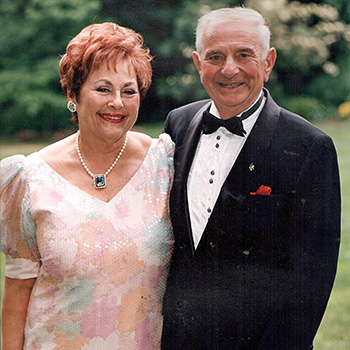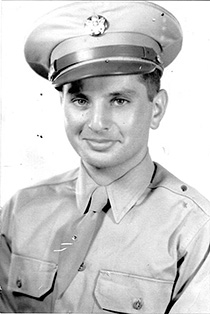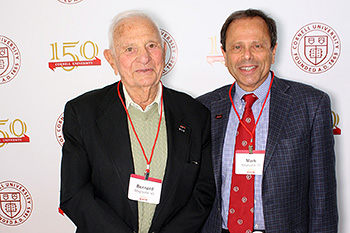
Bernard Mayrsohn '45, top row, second from left, appears in this photo taken the day that Russian troops liberated German prisoner-of-war camp Stalag 4B in 1945. A Russian captain took the photograph of Mayrsohn and four of his fellow soldiers with three female Russian military personnel. The photo became one of Mayrsohn's most treasured mementos. More than 50 years later, Mayrsohn tried to identify and make contact with the Russian soldiers who liberated him. Photo: Provided.
Veteran remembers Battle of the Bulge, looks forward to Reunion

Bernard "Barney" Mayrsohn '45 with his Cornell sweetheart and wife Ethel (Handelman) Mayrsohn '46. Ethel died in 2007; they were married for 60 years. Photo: Provided.
Bernard Mayrsohn '45 was 21 years old and a freshman at Cornell when World War II broke out. Along with his brother Jack Mayrsohn '50, he enlisted in the U.S. Army soon after the Japanese bombing of Pearl Harbor. In December 1944, he was stationed in the Ardennes region at the border of Germany and Belgium with the 423rd Regiment of the 106th Infantry Division when it was attacked by German forces in what came to be known as the Battle of the Bulge.
Mayrsohn and other Allied soldiers were captured and sent to Stalag 4B, one of Germany's largest prisoner-of-war camps (where, unknown to Mayrsohn at the time, fellow Cornellian and "Slaughterhouse-Five" author Kurt Vonnegut '44 was also detained). Five months later, Mayrsohn was freed by Russian forces and was awarded two Purple Hearts, a Bronze Star, and a Combat Infantry Badge upon his return to the United States.
Mayrsohn re-enrolled at Cornell on a G.I. Bill scholarship, married his college sweetheart Ethel Handelman '46, and completed his agriculture degree.
On the 70th anniversary of the Battle of the Bulge last December, Mayrsohn -- who is president of the 106th Infantry Division Association -- was among a small group of American veterans invited by the Belgian government as guests of honor at its commemorative celebrations. Mayrsohn participated in parades, reenactments and wreath-laying ceremonies in several towns, including the historic Saint Vith, where he delivered a speech.

Mayrsohn in uniform. He enlisted in the U.S. Army soon after the Japanese bombing of Pearl Harbor in December 1941. Photo: Provided.
"Every village had its mayor come out," he says. "The ceremonies were spectacular, with flowers and bands and orchestras."
Mayrsohn adds: "I felt very good about the whole thing. Of course, the Battle of the Bulge happened 70 years ago, and we were children then. Now we're old men."
The war is very vivid in Mayrsohn's mind, and he often looks back intently at his experiences: witnessing more than half of his colleagues fall against the Germans; detonating hand grenades to make foxholes in frozen ground during combat; marching for three days without a coat to get to the railroad cars headed for the prison camps; carrying a sick and bootless comrade to safety.
Mayrsohn is especially nostalgic for the moment the Russians liberated Stalag 4B. That day, a Russian captain had taken a photograph of Mayrsohn and four of his American comrades along with three female Russian military personnel -- a picture that has become one of his most treasured mementos. More than half a century later, with the help of the Russian Cultural Center in Washington, D.C. and the Office of Veterans Affairs in Moscow, Mayrsohn attempted to identify and make contact with his Russian liberators. While he hasn't yet found the officer and the women in the picture, he was able to travel to Moscow in August 2003 to meet and dine with other Russian soldiers from the same unit. (Read Mayrsohn's detailed account of this trip and meeting in a 2011 edition of "The Cub" (PDF link), the newsletter published by and for veterans of the 106th Infantry Division.)

Mayrsohn with son Mark Mayrsohn '77 at the Cornell sesquicentennial celebration in West Palm Beach, Florida. Mayrsohn also attended the inaugural sesquicentennial festivities in New York City last September. Photo: from Alumni Affairs and Development's "Cornell 150" Flickr gallery.
Now, at the start of spring, Mayrsohn's thoughts are turning toward his days at Cornell, warmer weather and his upcoming 70th Cornell Reunion in June. He is bringing several pieces of his war and Cornell memorabilia for the sesquicentennial "scanning" event and he is excited to take part in other university-sponsored highlights. He also looks forward to the class forums and presentations, including "Memories of December 7, 1941 and September 11, 2001," to be moderated by University Archivist Elaine Engst and co-sponsored by the Classes of '45 and '05.
For the 91-year-old Mayrsohn -- who has retired from heading a fruit and vegetable import-export business now run by his son Mark Mayrsohn '77 -- Reunion has become a family tradition as well as a time for remembrance. He thinks back on his brother Jack, who passed away last year, and recalls their shared experiences at Cornell and during the war. Above all, he continues to celebrate the memory of his wife, Ethel, who passed away in 2007.
"She was the brightest girl at Cornell, and a beauty besides," he says. "We were married for 60 years and we went back to Reunion every year. My kids also went to our reunion."
"I have many fond memories of Cornell," he adds. "But I give the university credit, most of all, for my marriage."